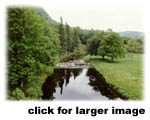
|
Inveraray Home of Mac Cailein Mor, Chief of Clan Campbell Photos and story by Brian Orr Have a question? Click Here to go to Brian's own Discussion Board!
The road to Inveraray from Oban takes you down the southern end of Loch Etive, through the Pass of Brander and around the north east end of Loch Awe where (at the southern end) on the Isle of Innischonnel, was the original Campbell stronghold
until the mid 15th century.
The town itself has quite a tale to tell.
This is the cross of the noble men, namely Duncan MacCom, Patrick his son, and Ludovick the son of Patrick, who caused this cross to be erected. The main occupation of Inveraray used to be herring fishing and the harbour was anciently called "Sloch a Chopper " - the gullett where vessels barter fish. A curious expression but descriptive of its activities none the less. The town arms is a net with herring, the latin motto "Semper tibi pendeat halec" translated as - may a herring always hang to thee. An interesting tale is told how the land for the first castle was acquired in the fourteenth centry by a little bit of sharp practice. The family had been given a tract of land on the eastern shore of Loch Fyne but covetted land on the opposite shore. Mac Ceilean Mor bargained with the McVicars, who owned the land, for as much land as could be covered by the skin of a foal, and, cutting the skin into thin ribbons and tying them together, measured and took possession of a considerable area. Work on the new castle was commenced in 1745 and finished about 1758 although decoration inside continued for many years thereafter.
This monument was originally erected in 1754 in Inveraray on a site which now forms part of the garden of the Bank of Scotland. The monument commemorates the execution by the 1st Marquess of Atholl of seventeen Campbell leaders in 1685. It was moved to its present position in order to make it more accessible to the public and where it was unveiled by the 10th Duke of Atholl in 1983. Inside the castle there are to be seen a wide variety of objects and art to which mere words cannot do justification. As perhaps should be expected of a distinguished family there are many mementoes as in the Armoury Hall where there are displays of arms. These include a selection of 16th and 17th century spears/lances, Brown Bess muskets, the huge war axes, and the equally huge broadswords that must have required a strong arm to wield. Amongst the displays there is also Rob Roy's sporran, belt and handle of his dirk.
The Tapestry Room contains original ( 200 year old) Beauvais tapestries and with it there is a fine selection of furniture from the late 18th century There are decorations, panels, lavishly ornamented ceilings and rich painting everywhere, and many family portraits by leading artists of their day. The China Turret has a splendid collection of Japanese Imari ware as well as Meissen, Worcester and Derby pieces. The inimitable Dr. Johnson, who visited Inveraray in 1773, said to Boswell: "what I admire here, is a total defiance of expense". There are not many places where you can see a designer made castle, designer made grounds and bridge and a designer made town for good measure. I would say idyllic sums it up. I hope this thumbnail sketch and views give you a taste of what lies ahead should you make a trip to Inveraray. It is a must for any Clansman visiting Scotland.
Meet the Authors
Back to Travels In Scotland, Main Page
Inveraray |
Thursday, December 26th, 2019
Attention visitors: Tartans.com is back. Please note that this is a snapshot of the site as it existed nearly 20 years ago and you may encounter broken links; we are still combing through the site and correcting those as we find them. Please also note that some sections are currently not functional, primarily the discussion forums/clan chat boards.
|
** HOME - First Time Visitors - Glossary - - Contact Us ** Awards | Bibliography | Clan Calendar | Clan Chat | Clan Finder | History | Famous Scots | Genealogy | Great Hall of the Clans | Links | News and Features | Scots on the Net | Search | Site Map The Gathering of the Clans
Copyright 1995- Tartans.com - All Rights Reserved. |
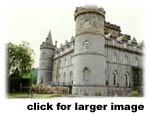
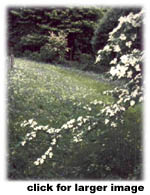
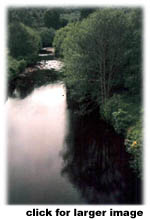
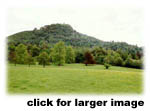
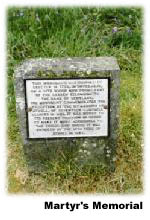 Within the grounds there is now the memorial to seventeen Campbells, the Martyrs, who were executed locally for having supported the Duke of Monmouth in the uprising he led against James II in 1685. Monmouth was a favourite and General of the Army but was exiled for involvement in a scheme to kill King Charles II and his brother James. He returned and was defeated at the battle of Sedgemoor soon after he landed, and executed at Tower Hill in London. The memorial used to be in a garden in the town but was relocated to the Castle grounds un 1983. The plaque reads:
Within the grounds there is now the memorial to seventeen Campbells, the Martyrs, who were executed locally for having supported the Duke of Monmouth in the uprising he led against James II in 1685. Monmouth was a favourite and General of the Army but was exiled for involvement in a scheme to kill King Charles II and his brother James. He returned and was defeated at the battle of Sedgemoor soon after he landed, and executed at Tower Hill in London. The memorial used to be in a garden in the town but was relocated to the Castle grounds un 1983. The plaque reads:
